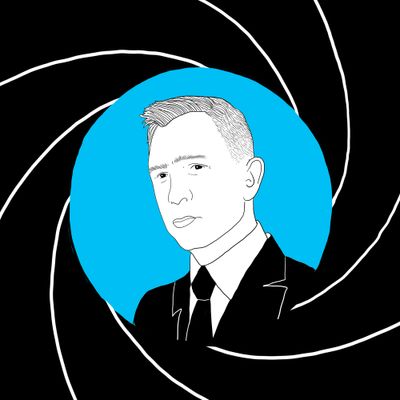
The latest installment of the James Bond franchise, No Time To Die, closes the book on the international superspy’s Daniel Craig era. Serenading both his exit and the conclusion of one of recent cinema’s great musical sagas is the theme song, “No Time to Die,” by Billie Eilish, Finneas, and Hans Zimmer.
Though Monty Norman and John Barry’s iconic “James Bond Theme,” written for 1962’s Dr. No, has remained a constant across six decades of espionage and one-liners, every new Bond theme has developed subtle variations on the original that reflect the character’s changes over time. On this episode of Switched On Pop, we uncover what inspired the theme, how it has changed, and why it almost never happened.
CHARLIE: I think we should start at the beginning, with the original 1962 theme from the first film, Dr. No. It’s such a part of pop culture. It’s pretty hard to hear it anew.
NATE: Listening to it now, one thing that strikes me is just how richly orchestrated this theme is.
CHARLIE: This song is crafted with the lushness to reflect the playboy aesthetic of James Bond when he was first created in the 1950s as a male escapist fantasy by Ian Fleming, the author and former British naval-intelligence officer. He wrote it at his Goldeneye estate in Jamaica to distract himself from his pending wedding to his pregnant fiancée, and in so many ways, the music, I think, does perfectly reflect the character.
NATE: You’re saying this is the musical personification of toxic masculinity.
CHARLIE: Yeah, more or less. You’ve got a philandering spy who drinks heavily and somehow finds a lot of time for romance in between international espionage.
NATE: Does the music actually project that?
CHARLIE: I think that what you hear is this very modern mash-up of a bunch of different genres that a playboy character might be listening to at the end of his day while he’s sitting down with his martini: jazzy chords, big-band swing, even surf guitar.
NATE: It sounds like he’s got a pretty diverse record collection that he likes to put on the hi-fi at his space-age bachelor pad.
CHARLIE: John Barry, who arranged the theme song, said that he wanted Bond to be a mix of all kinds of different things. When we hear the James Bond theme, we think, This is the sound of spy music, but like all original creations, it’s a compilation of so many influences. Just a few years before Bond, in 1954, Miles Davis played similar chords and melody on “It Never Entered My Mind.” Roy Orbison’s 1961 “Crying” uses the same chords and melody, too.
NATE: I love locating that undulating chromatic line within its late-’50s, early-’60s contexts. And I just have to say, Charlie, before we move on from this, one of my favorite factoids that I’ve ever learned in making our show is that when Smash Mouth recorded “All Star,” they used that same James Bond chromaticism in the chorus to their hit song, according to their songwriter Greg Camp. That little motif has some — some real longevity.
CHARLIE: It totally does. And it’s not the only reference that John Barry is pulling from. He said that he thought of the Bond theme as like a Dizzy Gillespie–style lick. All of that swing vibe that you’re hearing, where the bass starts to walk, it’s reminiscent of “A Night in Tunisia,” by Gillespie.
NATE: Now I understand why I loved this theme so much as a kid and used to listen to it all the time on cassette. It’s jazz. It’s a big-band swing composition, basically. It was right in my jazz wheelhouse.
CHARLIE: Totally, but it’s also a surf-rock thing. In 1958, the composer Henry Mancini had done the Peter Gunn theme song for the TV show. And it’s kind of moving into that surf realm. And we know Barry was very into this sound, too. He took the song “Walk, Don’t Run,” a Johnny Smith hit from the ’50s, and did his own surf rendition just a few years before Bond was released. By the way, the guitar player, named Vic Flick, was paid just £7 for recording the James Bond theme.
NATE: Seven pounds for the most iconic guitar playing of the 20th century? And his name is Vic Flick? It’s a travesty.
CHARLIE: You know, of all these references, we’re forgetting one of the most important: The big dissonant chord at the end of the Bond theme is also called the “Hitchcock chord.” You would have heard this in the theme for Psycho, in North by Northwest, and in Vertigo. The composer Bernard Herrmann loved this sound, and there’s a good reason why this Hitchcock chord gets passed on to Bond. It has so much ambiguity, dissonance, and complexity in this single tonality.
NATE: It’s like a chimerical chord. It’s got on its bottom a minor triad. And on the top, it’s got a major triad. And when you put them together, you just have such a unique, intense, crunchy sound. It’s a very evocative sound.
CHARLIE: It’s fitting that the James Bond theme draws from this cinematic history because the tension that we get from the Hitchcock chord for me represents this dueling personality in Bond. He’s the playboy spy who’s on the one hand responsible for saving the world over and over and over again while simultaneously continuing a tradition of toxic masculinity, which I think the series is desperately trying to separate itself from.
Listen to Switched On Pop to find out how the theme evolved over the years and how Billie Eilish, Finneas, and Hans Zimmer adapted it to close out the Daniel Craig era.

